Corrosion of Silver-Plated Copper Conductors - NEPP
Corrosion of Silver-Plated Copper Conductors - NEPP
Corrosion of Silver-Plated Copper Conductors - NEPP
You also want an ePaper? Increase the reach of your titles
YUMPU automatically turns print PDFs into web optimized ePapers that Google loves.
310<br />
Nickel finishes<br />
Advantages<br />
a. No known potential conductor corrosion risks.<br />
b. Very high temperature rating (260°C).<br />
c. Minimal storage controls needed.<br />
d. Good flexibility after long-term aging at 200°C.<br />
Disadvantages<br />
a. Impossible to solder with the non-activated fluxes prescribed by ESA 9 . With<br />
activated fluxes, it has a variable solderability, dependent on the type <strong>of</strong> nickel<br />
plating and thickness <strong>of</strong> nickel oxide. Active fluxes are undesirable for soldering<br />
hook-up wires as they are drawn under the insulation by capillary action <strong>of</strong> the<br />
strands and can cause corrosion, outgassing and corona problems under vacuum.<br />
b. Crimpability is fairly good, but more frequent adjustments have to be made to the<br />
crimping tool than with other finishes. Contact resistance is affected by the<br />
cleanliness <strong>of</strong> the surface. Ohmic resistance may be erratic for nickel platings<br />
(silver-plated copper connections exhibit negligible ohmic variations between<br />
similar joints).<br />
c. Nickel-plated conductors exhibit 7% to 10%. more DC resistance with<br />
substantially greater power (I 2 R) loss.<br />
d. Nickel has an unsuitable magnetic moment for certain spacecraft experiments.<br />
Reliability<br />
In assessing the reliability <strong>of</strong> a spacecraft system it is necessary to take into<br />
account individual materials, processes and their failure modes under various<br />
environmental conditions. In reviewing the above advantages and disadvantages <strong>of</strong><br />
silver and nickel platings much emphasis was attributed to the red-plague question.<br />
From a total <strong>of</strong> nineteen replies to the ESA survey in 1975 <strong>of</strong> European aerospace<br />
users <strong>of</strong> silver-plated wires, only one company had experienced a problem (no details<br />
given), six companies had 'minor problems', but all before 1965 and none since.<br />
Eleven companies had never encountered problems, including one using 400 km <strong>of</strong><br />
silver-plated cable per year.<br />
These investigations showed that no functional failure had been reported under<br />
operational conditions. Consequently, the selection <strong>of</strong> wire and cable materials would<br />
have to be based on controlled processing and well-defined application<br />
considerations. A similar survey performed by NEMA 6 supported the ESA findings.<br />
Processing precautions<br />
To minimise the occurrence <strong>of</strong> red plague, ESA has instigated a number <strong>of</strong><br />
requirements via specification SLP/2110:<br />
a. Prior to silver plating, conductors shall be cleaned with a reverse current in an<br />
alkaline bath.<br />
b. To avoid scratches, all drawing and stranding dies shall be exchanged regularly and<br />
whenever necessary.<br />
c. Drawing, stranding and braiding <strong>of</strong> silver-plated copper wire and shields shall not<br />
be performed with the same dies and tools used for processing tin, nickel, or<br />
other plated conductors.<br />
d. No lubricants shall be used during stranding or braiding.<br />
e. Water quenching shall not be used in the production process.<br />
f. Hygroscopic cleaning agents shall not be applied in production or during testing<br />
(no water-tank testing).<br />
g. Strands, wires and cables shall be sealed such that the humidity environment for<br />
storage and shipment is less than 50% relative humidity.<br />
h. All open wire ends shall be sealed against water ingress.<br />
i. <strong>Silver</strong>-plating thickness <strong>of</strong> at least 2 μm (80 μinch) is required for all strand<br />
sizes.<br />
j. <strong>Silver</strong> plating shall be uniform and concentric around the copper strand so<br />
ESA Journal 1984, Vol. 8


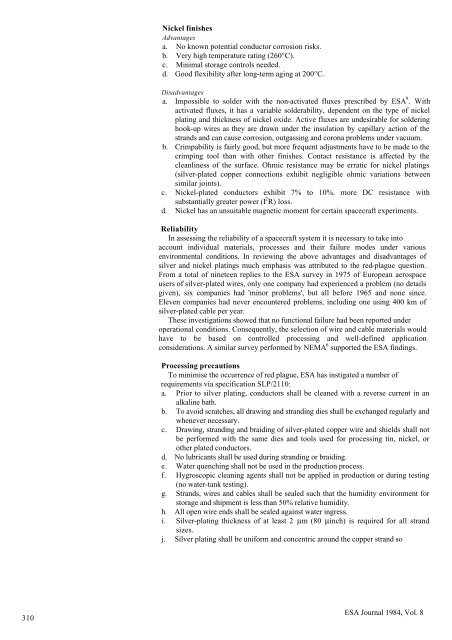
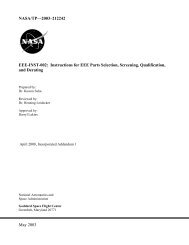

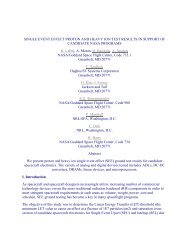
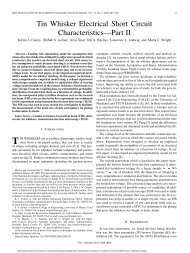
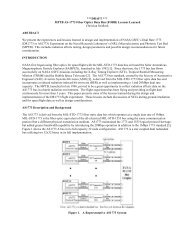

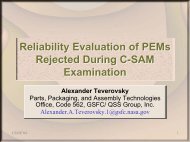
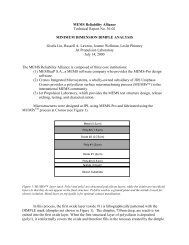
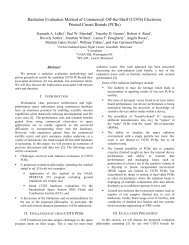
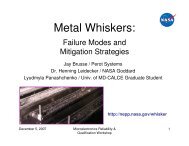

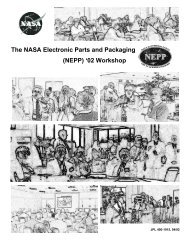

![mil-std-2223 [test methods for insulated electric wire] - NEPP](https://img.yumpu.com/4036001/1/190x249/mil-std-2223-test-methods-for-insulated-electric-wire-nepp.jpg?quality=85)